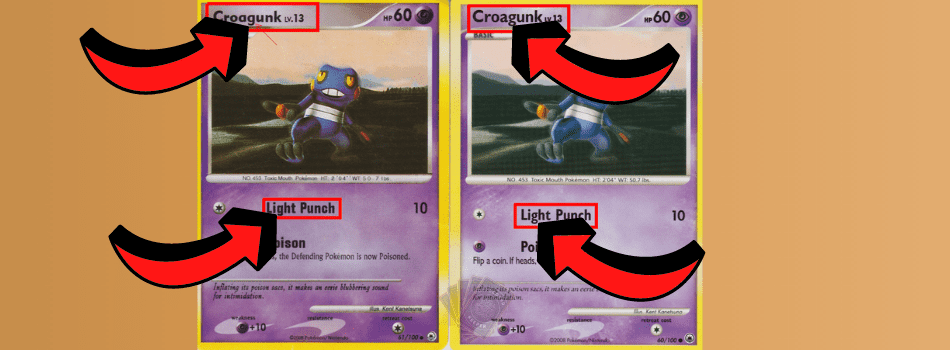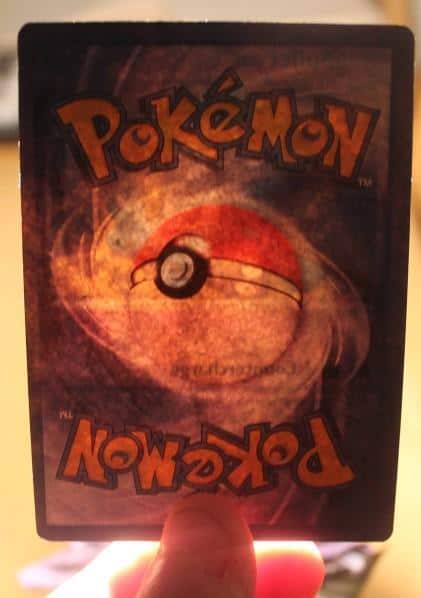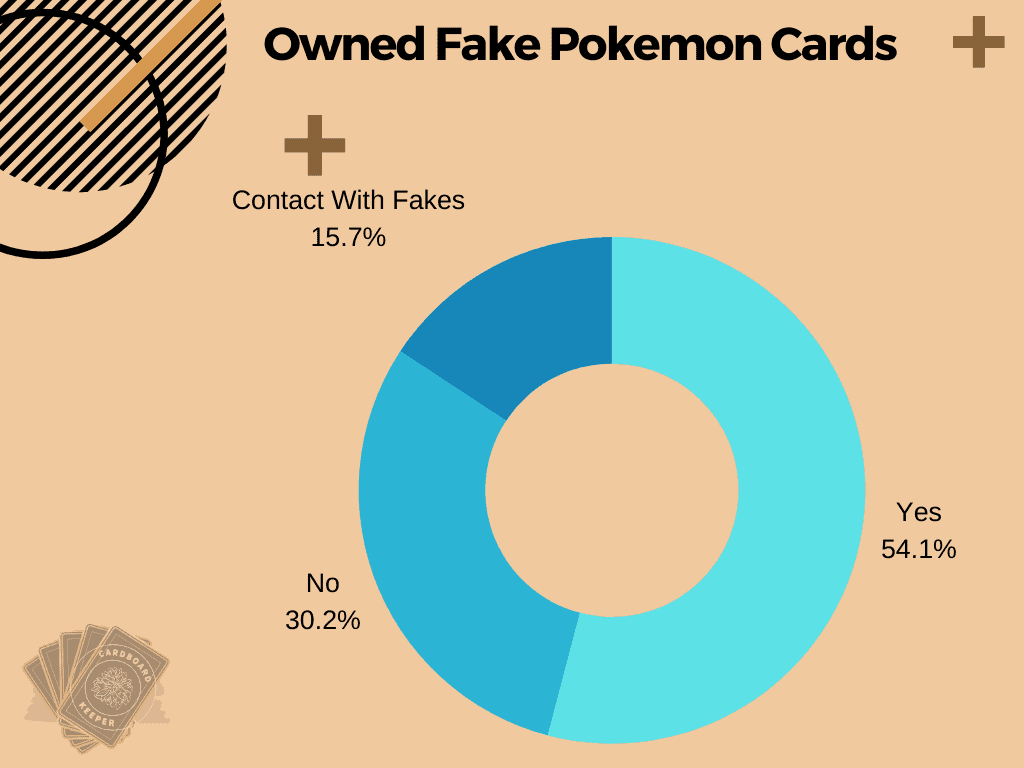One of the best feelings about being a Pokemon card collector is knowing that some of the pieces of cardboard tucked away in your binder can be worth a pretty penny – assuming they’re real.
Take it from me, there is no worse feeling as a card collector to find out your prized Pokémon trading card is counterfeit and worth less than the cardboard it’s printed on. That’s why being able to spot fake Pokemon cards is essential for all serious collectors.
To tell if a Pokémon card is fake or genuine, look at the color, font, spelling, symbols, texture, border, and the back of the card. There are also methods called the light and rip test. With practice, one can become an expert on determining whether or not a Pokémon card is fake.
I’ve dedicated this whole blog post to help you learn how to spot fake Pokemon cards so you can avoid any unfortunate surprises popping up in your card collections.
How Common Are Fake Pokémon Cards?
As time goes on, more and more fake Pokémon cards are created and get mixed up amongst genuine cards.
Don’t believe me? Check out this video from November 2021 where 7.6 tons of fake Pokémon tcg cards were confiscated at an airport in China planned for circulation on the English-speaking market.
What are the chances that you will come into contact with a fake Pokémon card to begin with?
What is the likelihood that these quick tips could really help you avoid disaster and save you from wasting money?
I surveyed 159 Pokémon card collectors from across the world and asked them if they had ever found a fake Pokémon card in their collection.
Over half the collectors I surveyed (54.1%) said “Yes”, they, unfortunately, had been victims of being sold or traded a fake Pokémon card in the past.
Only 30.2% of those surveyed said “No”, so far they had never come into contact with fake Pokémon cards.
The remaining 15.7% of the collectors I asked claimed that although they had never owned a fake Pokémon card, they had come into physical contact with them in the past.
That means almost 70% of the collectors we surveyed claimed that they had first-hand experience with counterfeit pokémon cards.
I don’t know about you, but I don’t like those odds.
Although my survey was broad, surveying collectors from across the globe, admittedly, my sample size is still rather modest, meaning those percentages could change if we were able to survey more collectors.
This is all to say, you shouldn’t be paranoid about running into fake cards and having the fear of counterfeits ruin the joy of adding to your ever-growing card collection.
Instead, by knowing a few simple ways to spot fake Pokémon cards you can be prepared for any encounter on the road to becoming a Pokémon master!
Just make sure you have all the right information. There are many tell-tale signs of counterfeit Pokemon cards. The more you know and practice, the easier it will be to spot a fake card and keep yourself protected from scams.
Font and Spelling of Counterfiet Pokemon Cards
The first thing you can do to check if a Pokémon card is fake is to look at the font, spelling, and colors.
Creators of fake Pokémon cards often slip up and spell things wrong. This is way more common than you might think and of course, it’s a dead giveaway that the card you’re looking at is counterfeit.
Research the card beforehand using a card game database so that you know the correct spelling of the words and phrases that should be on the card. Sometimes there may be different versions of the card from different countries and the spelling can be different than the original.
This isn’t likely unless you are trying to collect cards of a different language, but most fake cards are made for the English-speaking market, so you’re less likely to come across fake cards if you are collecting Japanese Pokemon cards instead.

If all of the spelling is correct, then make sure the font looks right.
Pokemon cards will often use a particular font, so knowing what that font looks like will come in handy. Pay particular attention to letters such as “y”, “g”, “a” or letters that are often stylized – the tail of a letter like “y” can often be an easy way to spot something wrong with the font of a card.
ProTip: if you can, have a real card to compare it to – ideally one from the same printed set.
Look at the font, the size of the font, and the placement of the words.
It’s all about looking into the little details. Check every part of the card that has a font and compare it to the real card – more often than not a counterfeit card will have a mistake here somewhere.
Incorrect Symbols On Fake Pokemon Cards
Energy symbols appear on most Pokémon cards and differ depending on what energy the card uses.
If a Pokémon card is fake the symbol could be faded, a different color, or misplaced on the card. They could be a different size, or a different symbol altogether!
Once again, it is important to look up the real card and know what symbols it has, what color they are, and where they are correctly placed on the card.
This may sound like another obvious thing to check and spot on a card, but I can’t stress enough that, because it seems so obvious to us, we often assume and don’t check these details before handing over our hard-earned cash!
Counterfeit Pokemon Card’s Borders and Texture
The border of the card can tell you a lot about the realness of the card.
Fake cards can look like they were punched out of cardboard, and for the most part, they are.
Producers of counterfeit Pokemon cards will often try to save costs on the printing and cutting process of making fake Pokemon cards – hence why these are often the easiest way to spot fakes.
To identify fake pokémon cards look for any indications of it being ripped out of cardboard on the edge of the card instead of being cleanly cut by a factory.
Oftentimes you can see tiny pieces of paper hanging off of the edge, proving that it wasn’t cut very well. It won’t be noticeable unless you look very closely at the edge of the card, so take some time to inspect the edges.
Looking at the texture of the card, its weight, and how it bends could be a dead giveaway to how genuine it is.
However, weight, texture, and the bending of cards fall more in the advanced category of identifying fake Pokemon cards.
For the sake of completeness, I’ll mention them here, but I don’t recommend most people who are just started out to use these methods to spot fake Pokemon cards.
These methods are good to know about, but there are other methods in this blog post that will serve you better if you are a beginner.
Thickness of Pokemon Cards
Genuine Pokémon cards often feel much thicker than Pokemon fakes. The material that real cards are made from typically will be of much better quality.
Bending Pokemon Cards
The additional thickness of a real card will often make it harder to bend.
Try and bend the card just a little bit, not enough to make a crease or damage the card. Then bend a card that you know is real. A real card should be harder to bend and a fake card is more flimsy.
Weight of Pokemon Cards
Fake cards also weigh less because of the lower quality material.
When you bend a card there should also be a certain noise that sounds like a pop. A fake card won’t make any noise because it is very flimsy and doesn’t have as many layers.
Texture / Finish of Pokemon Cards
The texture of a real card will be smooth with a matte finish.
Often fake cards have a shiny and glossy texture because they are produced in a less expensive manner. Manufacturers of the fake Pokemon cards will try to hide the counterfeit’s imperfections by making them shiny and a little harder to see clearly.
Light Test For Counterfeit Pokemon Cards
The light and rip test may be a little hard to do when you are in the middle of buying.
These next two methods could be helpful if you have already bought the card and have suspicions that it is fake.
The Light test is perhaps one of the most controversial and debated tests you can do to check the authenticity of a Pokémon card.
It is also one of the most involved and potentially time-consuming tests to perform correctly in order to draw an accurate result.
The concept of the test is simple, shine a light source at a Pokémon card and see how much light passes through or can be seen from the other side.

In theory, if the card you are testing is genuine, it should allow the same amount of light to pass through as all other genuine cards.
Whereas counterfeit cards, with a different, inferior, or sometimes inconsistent manufacturing process, will have inconsistencies in the amount of light that passes through them.
It’s recommended to use a “halogen light” when performing this test as some argue that the consistency and quality of light produced from these sources help with increasing the test’s accuracy.
Using sunlight isn’t recommended for this test.

Although this test may appear simple enough to perform, complications arise when you start to take into consideration other factors at play.
For example, Pokémon cards have actually been manufactured by two different companies, “Wizards of the Coast” and “The Pokémon Company”.
Each of these entities has had slightly different ways of manufacturing Pokémon cards which could affect the results of the Light test.
Using the Light test on cards manufactured by “Wizards of the Coast” tends to let through no light at all.
Whereas all non-holographic cards made by “The Pokémon Company” will let through a certain amount of light.
However, the amount of light let through by the card will differ depending on which set the card is from and even the color of the card.
It may come as no surprise that white cards will let through the most amount of light and black cards will let through the least, with all other colored cards letting through a similar (but not the same) amount of light to each other.
By now, I’m sure you can see why the light test can be considered pretty hard to carry out properly, but it does have its merits.

Unless you are using the exact same printing process as Pokémon company international, it’s almost impossible to have counterfeit cards mimic the correct amount of light pass-through while also getting everything else mentioned in this article 100% accurate to an authentic card.
So if you insist on performing the Light test here is what I recommend.
Regardless of whether “Wizards of the Coast” or “The Pokémon Company” printed the card, all cards during the light test should reveal some amount of black lines or veins running throughout the card’s layers of cardboard.
If you have the correct type of light available, you can use this as a quick way to check if those black lines are present. Unfortunately, if they are present it doesn’t guarantee the card is genuine as there are some counterfeit cards that will try to mimic this during similar tests.
If you would rather try to measure the amount of light passing through the card, then I suggest getting a card that is from the same set or, better yet, borrowing the exact same card from a friend and comparing how the cards perform under the same light test.
In a controlled test environment, you should get the same result if both cards are genuine.
Rip Test Check For Fake Pokemon Cards
The Rip Test should be your absolute last resort because it is just as it sounds.
You have to rip the Pokémon card.
This may be very difficult to do, especially when the card is worth a lot if it were to be real and genuine. All you have to do is rip the Pokémon card down the middle. There should be several layers of the paper and a black or blue line in between them.
This is from the colored layer of paper that they put in the middle during the manufacturing process. If the card doesn’t have a colored line in the middle then it is fake.
I don’t recommend doing this often. Only do this if you are almost positive that it is fake.
Imagine the disappointment you would feel if the card turned out to be real. Nothing is worse than destroying a real card, with a high value.
People who make fake Pokémon cards often don’t create cards with that extra layer in the middle, because they don’t expect anybody to actually rip it.
A good tip is to do this when you are buying cards in bulk. One card out of multiple won’t hurt you too much and then you can know for sure if the whole set of cards is real or not.
How to Tell the Back of A Genuine Pokemon Card
The back of the card is the same on all English Pokémon cards.
Keep in mind that Japanese Pokemon cards typically use a different card back design from the rest of the world.
It has the Pokémon logo in its iconic color and font, with a blue background and the Pokémon ball with white around it, to show that it is in motion.
Anybody will see this backside of the card and know it is a Pokémon card. Since the back of the Pokémon card is so recognizable, fakes will work hard to make it look the same. However, you will still be able to tell the difference between the back of a fake and genuine Pokemon card.

Look to the top right of the Pokémon card and compare the card you are considering buying with a real one.
You will notice on all real Pokémon cards, there is more than one shade of blue present in the background. A fake card will have mostly one solid shade of blue running throughout its background.
Manufacturing Counterfeit Pokemon Cards
When Pokémon cards are made, no steps are skipped. From the quality of the paper to how many layers of paper there are, Pokémon cards are high quality and can’t be beaten by the fakes.
However, it is inevitable that cards will fade over time if they aren’t protected properly. Most owners do take good care of their cards and they should stay in good condition. Therefore, it’s important not to assume any deficit you see on a Pokemon card is due to wear and tear over time of the card’s life.
The “damage” you see on a Pokemon card might actually be due to the inferior manufacturing process of counterfeit card producers.
Packaging is also an important factor in telling if a card is fake. Of course, if you are buying a single card it won’t be in packaging.
However, if you are buying a pack of cards, that is a different story. Pokémon cards have their own unique packaging that isn’t generic. The plastic wrap on real cards has the Pokémon ball pattern on it, while fake packaging does not.
Look for any signs that the cards have been repackaged, or packaged with tape. If you see boxes of cards that look they have been rewrapped, avoid them!
Pokemon packaging will have the print year, often on the back of the box or packet. If it isn’t anywhere on the card, most likely it is fake.
Some Pokémon cards have holographic effects on certain parts of the card, but not the whole thing. Do some research so that you know what areas on the card should be holographic.
Becoming An Expert In Spoting Fake Pokemon Cards
The most common way for you to accidentally buy a fake Pokémon card is by not knowing enough.
The more you know about Pokémon cards, the more you will be able to tell if they are fake or not. It just takes practice.
At first, you may start out with a checklist of items to check for, but eventually, it will become like second nature. There are many people who take one look at a card and know if it is fake or not They have had years and years of practice, and that could be you someday.
You just need to set aside some time and dedicate yourself to knowing all of these small but important details of the Pokémon card.
A huge tip from professionals is to only buy cards from a local game store. This will highly decrease the chances of buying a fake card. They aren’t going to try and sell you a fake Pokémon card, because they have a reputation to protect.
Nobody is going to buy more cards from them if word spreads that they sell fake cards.
Check out this video from a real card store owner who uses their years of experience to help you spot fake Pokemon cards.
When buying or trading Pokémon cards, you need to be careful about fake cards.
Almost everybody in the Pokémon card has probably come into contact with a fake card, without even knowing it. So be careful out there on your cardboard journey – It will be worth it in the end!

